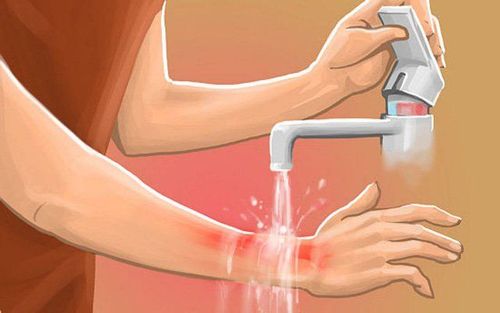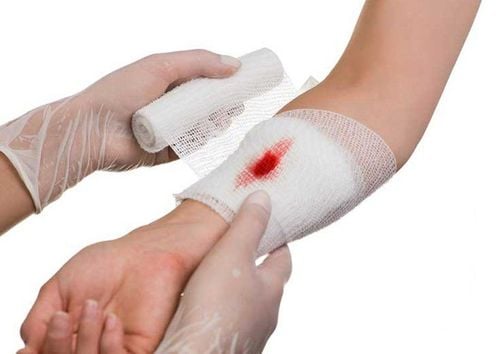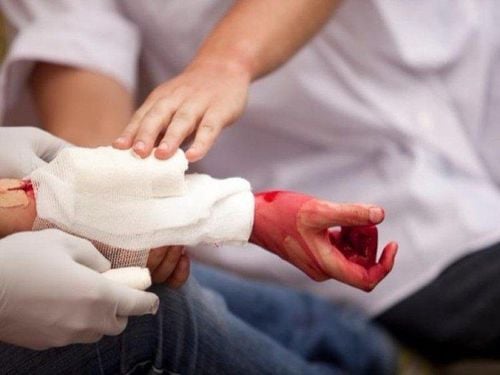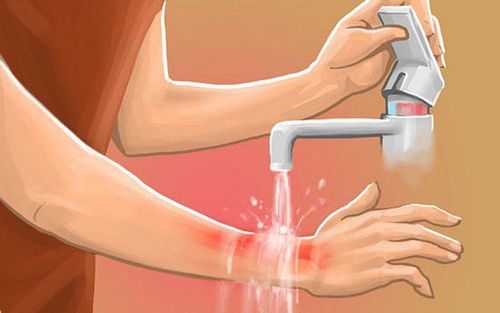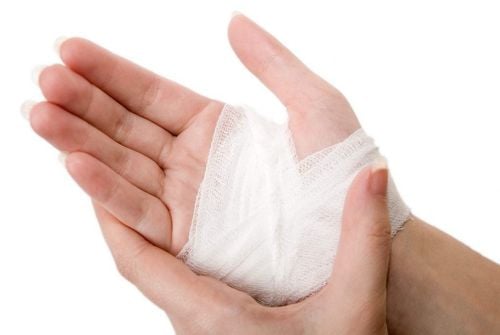This is an automatically translated article.
Article written by Specialist Doctor II Phan Phi Tuan - Department of General Surgery - Vinmec Phu Quoc International General Hospital
Patients with burns from 20% to 39% of the body area often develop severe symptoms. The dressing change work in this group requires ensuring the number of staff (minimum 4 people), at the same time ensuring full body pain relief, ready to resuscitate
I. Outline
1. Purpose of the burn dressing change
Clean the burn, remove fluid, stagnant pus,.... to support the quick healing of the burn. Use topical medications. Additional diagnosis of area, depth and monitoring of the progress of the wound. burns Necrotizing excision or skin graft preparation, suture removal
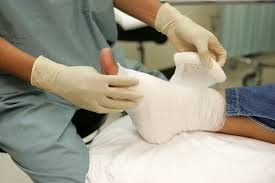
2. Request for dressing change
Ensure sterility, prevent cross-contamination Change dressing gently and meticulously Anti-pain, without causing bleeding or peeling skin grafts Conducted when the whole body condition is temporarily stable. For patients with severe burns, change the dressing when the respiratory and circulatory status is controlled. Patients with burns of 20%-39% of the body area often develop severe symptoms. The dressing change in this group requires a sufficient number of staff (minimum 4 people), at the same time to ensure full body pain relief, ready to resuscitate.
II. Point
Change the wound dressing with a new burn to treat the first stage.
Change dressings to treat burn patients regularly:
Severely contaminated wounds (a lot of fluid, pus,...): Change the dressing 1-2 times a day. Less contaminated burns (clean, little discharge): change the dressing every other day.
III. Contraindications
There are signs of life threatening function such as respiratory failure, cardiovascular collapse, shock..
IV. Preparation
1. Staff
Minimum dressing change crew of 4 people: 1 treating doctor, 3 nurses specializing in burns or trauma (1 sterile to help outside, 2 sterile). Anesthesiologist and anesthesiologist (if needed).
2. Means, Tools
Tray of beans, cotton, bandages, gauze, gloves, sterile cloth. Fork with nodule, curved scissors, straight scissors, gloves. Should have available tools to stop bleeding such as pince, pliers...
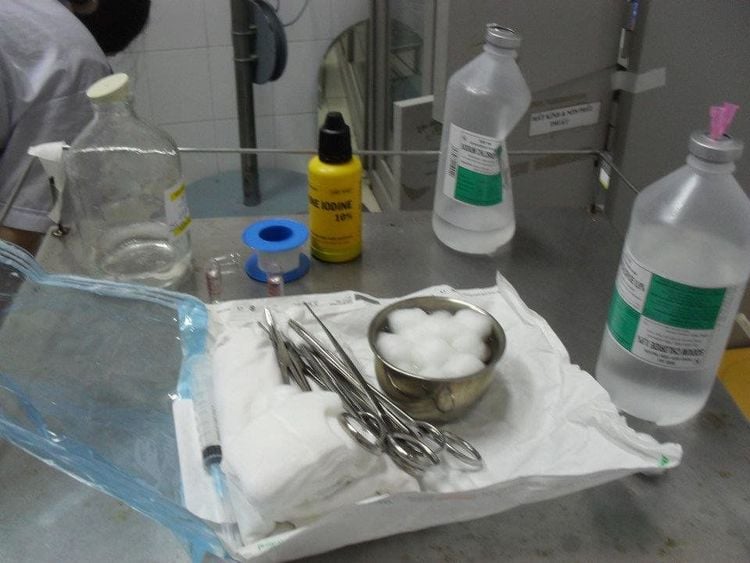
Dirty bucket. Medicines for changing burn bandages.
3. The sick person
Explain and encourage the sick person, their family, and caregivers. Instruct the patient to fast for 6 hours before anesthesia is required. Test for drug reactions (if needed). Check pulse, temperature, blood pressure, respiratory status...before dressing change.
4. Place of dressing change
Regularly disinfect after each day of dressing change. The room should be equipped with resuscitation equipment such as ventilators; supply The dressing change is carried out in a dressing room, preferably a sterile one and usually oxygenated; vaccum; monitor to monitor patients; other necessary emergency equipment and medicine.
Order of patients to change dressing
Prioritize patients who need to be treated first, patients after skin grafting, followed by patients with narrow burn area, little pus, then patients with scars extensive burns, and finally in patients with severe infections. Patients with sepsis, infectious disease or HBsAg, anti-HIV (+) tests must be changed according to the isolation regimen with a separate dressing change set.
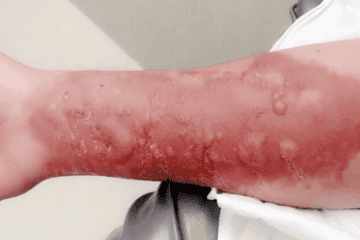
5. Sterile
Ensure aseptic regulations in dressing change: Staff members change dressings and wash hands; wear sterile hats and masks; wear sterile gloves. Sterile dressings must be used by each patient to avoid cross-contamination.
Each patient has their own dressing tray and is carefully disinfected. Before changing the dressing for the next patient, change the cast iron, clothes and wash hands.
V. Steps to take
The treating doctor will directly examine and direct the dressing change to assess the wound, prescribe drugs or skin substitutes to be used on the burn site and treat the burn wound with the dressing crew.
Anesthesia : Use general anesthetic or anesthetic (according to own procedure).
Step 1: Remove the old dressing and the outer layers of bricks. The sterile nurse takes the patient into the dressing room, to lie on the dressing table (or hospital bed); Use scissors to cut off the old bandage, remove the outer layer of gauze, leaving the innermost layer of gauze. Use sterile physiological saline solution or diluted potassium permanganate to moisten the innermost layer of gauze.
Step 2: Remove the innermost layer of gauze and clean the burn Aseptic nurse peels off the innermost layer of gauze (remove the gauze parallel to the skin surface), taking care to be gentle so as not to cause bleeding and pain for the person sick.
Use soft gauze or sterile cotton balls soaked in saline solution (or indicated antiseptic solutions) to wash the burn; remove pseudomembrane, foreign body; excision of necrosis that is shedding or remaining after surgery (if any). Wash in order from clean area to dirty area, first wash the head area, the foot area, the perineum area wash last).
Treatment of the burn nodule: if the burn nodule is intact, not infected: make an incision, cut through the burn, remove the burn fluid, try to keep the burn dome, then apply pressure. If the burn is infected: remove, drain the blister.
During dressing change, if bleeding: apply gauze soaked in warm salt water or impregnated with adrenaline 1/200.000 solution, or by measures such as electrocautery, blood vessel constriction...
Wash the burn with a solution of antiseptic bacteria. Blot dry.

Step 3: Using topical medication for burns Based on the progress and condition of the wound, the doctor will decide to use topical treatment for burn injuries.
The aseptic nurse prepares topical medications or skin substitutes. After cleaning the burn, apply topical medication to the burn in one of the following ways:
+ Apply the medicine directly to the burn with a thick enough layer to cover the entire burn area, then apply a layer of gauze to the burn. externally. It is recommended to apply another layer of gauze impregnated with vaseline outside the innermost layer of gauze. Then apply several layers of sterile gauze in the style of tile roofing (the thickness of the gauze depends on the state of exudate, wound pus, usually 4-6 layers of gauze).
+ Soak the medicine in a layer of gauze and then cover the burn so that the edges of the gauze sheets partially overlap; apply a layer of gauze impregnated with vaseline on top of the medicated gauze; Apply several layers of sterile gauze in the style of tile roofing (the thickness of the gauze depends on the state of exudate, wound pus, usually 4-6 layers of gauze).
For burns on granulomatous tissue preparing for skin grafting, do not apply the drug directly to the granulation tissue 2-3 days before skin grafting.
Step 4: Bandage the burn, bring the patient to bed and monitor after the dressing change. The nurse helps in addition to dressing the burn with a bandage or mesh bandage, not too tight, affecting the patient's circulation.
Take the patient to bed, check the patient's respiratory index, pulse, temperature, blood pressure and hand it over to the nurse in the ward.
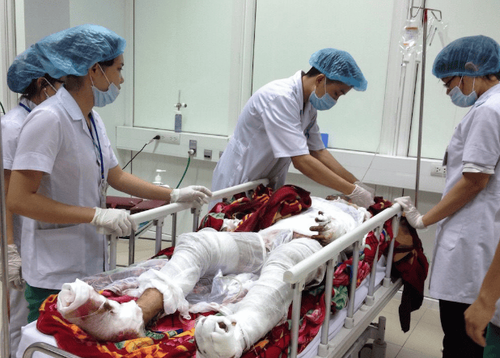
BECAUSE. Monitoring and handling of accidents
1. Full body
Monitor the state of the whole body, pulse, temperature, blood pressure ... after changing the bandage closely, promptly detect the state of shock, threatening shock for handling. Patients with dizziness, fainting during and after the dressing change: Pause the dressing change, lay down in a cool, airy place, give oxygen, and heart medication. When the patient wakes up, returns to a stable state, allowing the dressing to be changed again. Monitor side effects of systemic analgesics or general monitoring after anesthesia for timely handling such as cardiac arrest, vomiting... Painful condition after dressing change such as pain, chills or fever high: continue to use pain reliever, warm, reduce fever...

2. On the spot
Retract the dressing to expose the wound: apply additional dressings. The condition of the bandage is too tight causing edema, compressing the burn area: common when changing the dressing in the first 3 days (the burn continues to edema) or after skin graft surgery: loosen the bandage, even check the incision for necrosis. Release compression when indicated (according to separate procedures). Bleeding: Change the bleeding area, apply warm saline, apply pressure or stop bleeding if necessary, remove the blood clot, re-apply the medicine gauze, vaseline gauze and dry gauze, pressure bandage.
Please dial HOTLINE for more information or register for an appointment HERE. Download MyVinmec app to make appointments faster and to manage your bookings easily.





